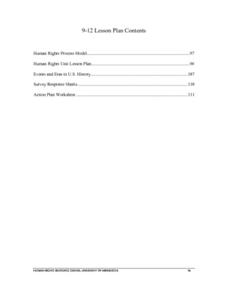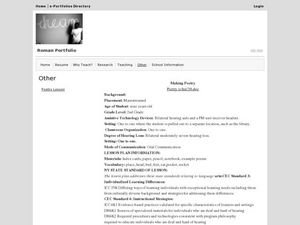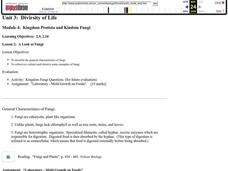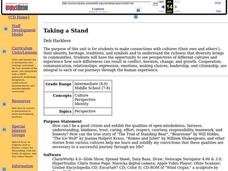Curated OER
Back to Basics
Students examine the unique and diverse historical artifacts that people have designed to fulfill their everyday needs in extraordinary ways. They identify ways humans have used design throughout history to enhance the ways they meet...
Curated OER
Two Sides, Same Coin: How Political Beliefs Influence Language Use
Learners read several magazine articles on the same topic written from different political perspectives, paying particular attention to the diction, syntax, and arguments presented in support the point of view expressed. They then select...
Curated OER
Passport to Africa
Middle schoolers begin the lesson by reading a novel about the diversity of geography in Africa. They are to create an oral report based on information they research. They also communicate with someone through email about the situation...
San Bernardino Co. Supt. of Schools
Was Julius Caesar a Good Leader for Rome?
Learners consider the various perspectives that different groups in Roman society may have had for Julius Caesar, such as Roman soldiers, senators, the working class, and slaves. The primary activity involves a reading of Caesar's...
Curated OER
Introduction to Tibet
Students examine Tibetan history and geography. In groups, they analyze and discuss different perspectives regarding the Chinese occupation of Tibet. Students discuss current events and their significance. They write an article and...
Curated OER
As the Kids Come and Go: Mapping a Classroom
Map the classroom with your kids to help them understand how maps work and how to read them. The lesson starts off with a story about animals living and moving around the globe, and then kids create maps of their classroom to show how...
Curated OER
Author's Purpose
Sixth graders brainstorm the reasons authors write, and they list their responses on the board. Students discuss each purpose they have listed.Students work independently to read the selection "Tarantulas and Typhoid" by Stephanie Moss....
Curated OER
Korea's Literary Tradition
Students read a text about Korea's literary tradition. In this literary tradition lesson, students read the multiple page text to learn about Korea's literary tradition.
Curated OER
Everybody Cooks Rice
Students read the book, "Everybody Cooks Rice," and they participate in activities pertaining to the book. They identify countries mentioned in the text and locate them on a world map. They use an atlas to identify the climatic...
Curated OER
Putting On Armor
Seventh graders are read the story "EMS Code Blue" and asked to share what they would do in the different situations. As a class, they discuss the importance of getting help for mental or social problems and are given a list of resources...
Curated OER
A Day at Mount Vernon
Students discover daily life on George Washington's plantation, Mount Vernon. In this compare and contrast lesson, students examine the life styles at four distinct sites at Mount Vernon to become familiar with the people, places, and...
Curated OER
Searching for Ourselves in Novels
Students select a novel of their choice and complete assignments that are self-assigned. Students display responsibility in completing self-assigned projects and meet deadlines.
Curated OER
Social Studies: Human Rights Then and Now
Students examine past and present human rights issues in U.S. history. In reflection journals, they document both justices and injustices perpetrated on groups and individuals. Finally, students implement an action plan designed to...
Curated OER
Making Poetry
A hearing impaired student identifies rhyming words. In this rhyming word lesson for the hearing impaired, 2nd graders read and write poetry correctly using rhyming words.
Curated OER
Funeral Rites Research
Students compare their own cultural/religious beliefs and traditions of death and funerals with those of another culture. They conduct research, and write a research paper.
Curated OER
Quilting Canada
Students explain the symbols of Canada and their relevance. For this Canada lesson, students read Oh Canada and exchange pen-pal letters with students in Canada. Students create a class quilt with Canadian symbols.
Curated OER
Religion and Deaf Education: The Contract Between Clerc and Gallaudet
High schoolers examine the issues surrounding the prevailing religious and cultural beliefs in the early 19th century United States and how they influenced the education of deaf people. They apply this information to modern day contexts.
Curated OER
Famous People of Japan
Students conduct research to follow several essential questions that guide the instructional activity. The concern of the student research is the finding of contributions of famous Japanese to the culture of the United States.
Curated OER
"Angel Child, Dragon Child"
Students read and analyze the book "Angel Child, Dragon Child" by Michele Maria Surat. They chart the main story elements on a graphic organizer, and write three sentences about themselves and draw a self-portrait. Students then create...
Curated OER
It's in the Elements - Lesson Four
Young scholars compare and contrast story elements in two versions of Cinderella. In this literature elements instructional activity, students are read two different versions of Cinderella, they identify the characters, plot, and...
Curated OER
Ecosystems: Biotic and Abiotic Factors
Seventh graders examine proper journaling techniques, and record observations about at tree after listening to a read aloud of "Four Worlds: The Dine Story of Creation." They study the difference between living and non-living things, and...
National Endowment for the Humanities
Chinua Achebe's Things Fall Apart: Oral and Literary Strategies
Readers are first introduced to Chinua Achebe's Things Fall Apart by making a map of Africa. They will better understand the novel's historical and literary contexts, European and African literary traditions, and how historical events...
Curated OER
Diversity of Life
Students study fungi and its characteristics. In this fungi lesson students collect and observe fungi then answer questions on what they saw.
Curated OER
Taking a Stand
Students make connections with cultures (their own and others'), their identity, heritage, traditions, and symbols and examine the richness that diversity brings to communities.

























